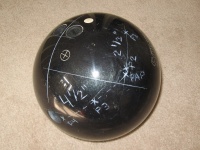Gradient Line Balance Hole
Contents
Using the Gradient Line Balance Hole
Before we can determine what Gradient Line Balance Hole we can place, there are a few extenuating details we must first consider. The most important of those being the static weights of the ball we are drilling. For example, if we have intentions of placing a low balance hole, typically P3 and P4 locations, we need to ensure we have some thumb weight (less than 1oz) and a little positive side weight (less than 1oz) because drilling low balance holes will remove weight from the positive thumb quadrant of the ball. By ensuring the ball has less than 1oz of thumb and positive side weight, the ball remains legal if we decide we don't want the balance hole after all.
To ensure we get this kind of configuration with the minimum of effort, it's best to use longer pin out balls (3" or more pin to CG), as these give us a greater chance of getting the CG marker at least near the center of grip. If you can get the CG on the midline and slightly to the right of the centerline, we have access to the widest range of Gradient Line placements, with a minimum of fuss. Placing the CG in this position, gives you a minimum of finger/thumb weight (depending on the depths of the finger and thumb holes. See below.) and a little positive side weight. While this configuration gives us access to all balance hole positions, the allowable balance holes will be on the small side, unless we manipulate the static weights a little more. The further below the mid line the CG gets, the bigger you can make low balance holes.
In the case of a Double Thumb balance hole, to get the most out of the balance hole, you probably want at least 1/2 oz of thumb weight, since a 1" diameter hole, drilled 3" deep removes over 1 oz of thumb weight from the ball.
Please note the location for p1 has changed, pending final investigations. Discussion here http://forum.bowlingchat.net/viewtopic.php?f=13&t=2454
Manipulating Static Weights
Some times, even after we place a balance hole, we might want to make the balance hole deeper, or bigger. If the static weights don't allow that, there are a few things we can do.
If we need to increase thumb weight, the easiest way to do this is to drill the finger holes deeper, up to 4.25" deep. Most of the time, finger holes are drilled at a depth between 1.75" to 2", removing around 1/4 ounce a piece.
If we need a more positive side weight, one way to get it is to drill the middle finger hole much deeper than the ring finger hole, up to 4.25" deep.
The Gradient Line and Symmetrical balls
There seems to be a little confusion surrounding the use of Gradient Line placements in Symmetrical balls. The most confusion seems to be surrounding the placement of P3 and P4 holes.
Since we know that the PSA in drilled symmetrical balls end up within 0.5" of the center line and 6 3/4" away from the Low RG Axis (without a balance hole), it can be argued that the thumb hole IS a P4 hole. It is true that we can never have a true P4 hole on a symmetrical ball, we can get close by taking advantage of the fact that the PSA moves closer and closer to a balance hole as that hole gets bigger and/or deeper.
If we drill a LARGE balance hole (let's say 1.25" in diameter, 3.5" deep) at a location 6.75" from the marked Pin on a line through the marked CG, we know that the actual PSA will be much closer to the balance hole than the thumb hole. While the PSA might not move all the way to the hole, it will be about as close as we will get. The closer the balance hole is to the thumb hole, the closer we get to a true P4 hole.
Another alternative to simulating a P4 hole in a symmetrical ball is drilling the thumb hole deeper, removing more core material from the High RG axis.
Remember, the ONLY reason we use the line from the marked Pin through the CG is to ensure we have the CG in favorable locations for Gradient Line placements.
Pitched Balance Holes
In most cases, we don't need to worry about pitching balance holes at all. However, in cases where the balance hole is going to be close to one of the gripping holes (such as the balance hole in the Double Thumb layout), we must pitch the balance hole away from the gripping hole to ensure the bottom of the balance hole does not intersect with the bottom of the gripping holes.
In general, the amount of pitch we need will be the at least the difference of the depth of the gripping hole and the distance of the center of the weight from the gripping hole, plus and lateral pitch present in the thumb. Using the Double Thumb Layout as an example, we know the center of the balance hole is 1.5" from the edge of the gripping hole. If we have drilled the thumb to a depth of 2.5", we must pitch the hole at least 1" away from the balance hole. If the thumb hole has any lateral pitch toward the balance hole, we need to add that much more pitch to the balance hole. Conversely, if the thumb hole has any lateral pitch away from the balance hole, we can remove that much pitch from the balance hole.
